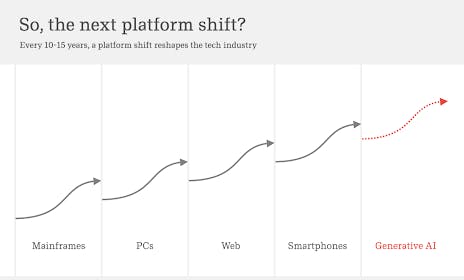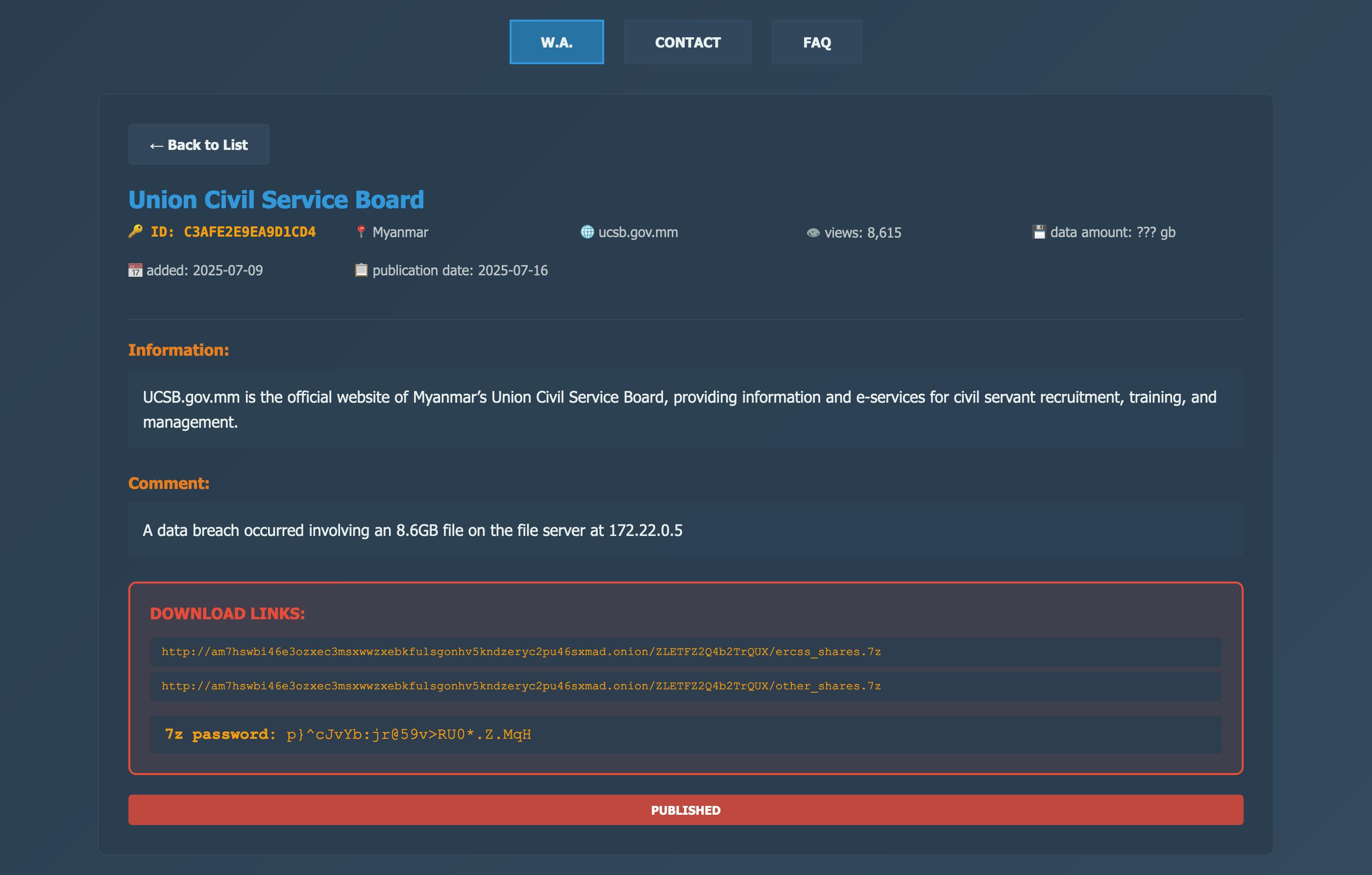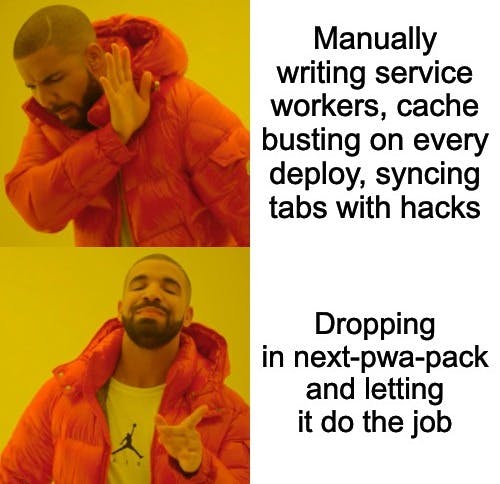This post is the first in a series where I explore whether emerging technologies can fix the broken internet. It all started with a simple question: Why do I find myself rooting so strongly for AI to disrupt the current status quo in tech?
I think it’s because Big Tech giants have become cumbersome monopolists, wearing everyone down.
In this initial post, I’ve aimed to outline what’s wrong by breaking down my criticisms of the five major companies: Google, Meta, Apple, Microsoft, and Amazon. It’s important to see the whole picture clearly before addressing the deeper question:
Do we have a genuine chance to build a healthier future for the internet?
Five Years
Putting all the hype around AI aside, the past five years in tech have been pretty boring. Sure, there have been some cool moments:
- Elon Musk’s rockets made space exciting again
- The electric car industry has been booming
- Apple released powerful new chips
- Some attempts at VR, the slow rollout of 5G, and crypto
But overall, life hasn’t changed dramatically. We’re already used to the current technology stack. All the groundbreaking ideas were pretty much delivered by Steve Jobs. What we got after him are mostly incremental improvements on already decent products.
But that’s without AI in the picture.
Opinions on neural networks vary wildly. Some dismiss them as nothing more than stochastic parrots. Others are already feeling the AGI and juggling ten open tabs with various AI tools.
Regardless, their popularity is undeniably growing. It’s hard to find a conversation these days where neural networks don’t come up at least once.
Companies are throwing more and more cash into AI infrastructure every year.
Now, almost every startup claims to be AI-powered by default (okay, not every single one, but a significant chunk).
For the foreseeable future, AI is becoming an integral part of our culture.
Venture
I wrote this post inspired by an interview with Marc Andreessen.
If you don’t feel like watching the video, I’ve transcribed some parts below.
Jack Altman: Do you feel that we’re now at the beginning of the next important paradigm? Like is this cloud, but on steroids?
Mark: Oh yeah, I think much larger, and I’ll explain why.
The technological changes, drive the industry. When there is a giant new technology platform, it’s an opportunity to reinvent a huge number of companies and products that have now become obsolete and create a whole new generation of companies, often end up being bigger than the ones that they replaced.
In venture, the returns map this. There was the PC wave, the internet wave, the mobile wave, the cloud wave. And then, when you get stuck between waves, it’s actually very hard. For the last five years, it’s like, “Okay, how many more SaaS companies are there to found?” We’re just out of ideas, out of categories. They’ve all been done. And it’s when you have a fundamental technology paradigm shift that gives you an opportunity to rethink the entire industry.
Before this, I hadn’t really considered the past few years as a period of boring stagnation. Without LLMs and scalability experiments, things definitely wouldn’t have been as interesting.
Jack: It would have been very sad, if the AI breakthrough didn’t happen. The state of venture would be sad.
Mark: Chris Dixon has this framing he uses “In venture, you’re either in search mode or hill-climbing mode.” And in search mode, you’re looking for the hill.
Three years ago, we were all in search mode, and that’s how we described it to everybody. Which was like, “We’re in search mode, and there’s all these candidates for what the things could be.” And AI was one of the candidates. It was a known thing, but it hadn’t broken out yet in the way that it has now.
Now we’re in hill-climbing mode.
A year ago you could have made the argument that, “I don’t know if this is really going to work,” because of hallucinations or “It’s great that they can write Shakespearean poetry and hip-hop lyrics, can they actually do math and write code?”
Now they obviously can. The moment for certainty for me, was the release of o1 by OpenAI. The minute it popped out and you saw what’s happening, you’re like, “Alright, this is going to work because reasoning is going to work.” And in fact, that is what’s happening. Every day I’m seeing product capabilities and new technologies I never thought I would live to see.
The waves and hills idea isn’t new.
But what caught my attention this time was how vulnerable Big Tech companies might be to disruption from this new wave.
I actually think the analogy isn’t to the cloud or to the internet. I think the analogy is to the invention of the microprocessor. I think this is a new kind of computer. And being a new kind of computer means that essentially everything that computers do can get rebuilt.
So we’re investing against the thesis that basically all incumbents are going to get nuked and everything is going to get rebuilt.
AI makes things possible that were not possible before, and so there are going to be entirely new categories. We’ll be wrong in a bunch of those cases because some incumbents will adopt.
Jack: Obviously incumbents are going to win some percentage and startups are going to win some, but it’s basically the dominant strategy as a venture capitalist to just plan to bet that startups are going to win it all and go for the power law?
Mark: That’s right. The reason is because there’s two customer sets. The way the LPs think of us is as complementary to all their other investments. Our LPs all have major public market stock exposure. They don’t need us to bet on an incumbent healthcare. They need us to fit a role in their portfolio, which is to try to maximize upside based on disruption. And the basic math of venture is you can only lose 1x, you can make 1,000x.
Of course, Marc is deeply invested in these ideas, so it’s wise to approach his forecasts cautiously.
Yet, while listening to him, I realized it doesn’t really matter if it’s hype or not. No one knows exactly how significant neural networks will become or whether new companies can truly make positive changes.
But I found myself genuinely, strongly HOPING Marc is right.
Because today’s internet feels broken.
Big Tech companies are doing lots of cool stuff. But in my opinion, they’re not delivering enough value to justify their massive market capitalization.
To illustrate, here’s a graphic of the S&P 500 index—which includes the 500 largest companies in the US. Big Tech has grown so large that it now accounts for a quarter of the entire index!
I got curious about my slightly irrational desire to believe everything I heard in the interview. So let’s start with something.
Why exactly do I think the internet is broken?
The quality of Google’s search results has been declining steadily for several years now.
Here’s a quick example: best vpn 2025. First, you’ll see ads that fill the entire screen. Then, you’ll get reviews carefully packed with SEO keywords and affiliate links. Companies pay reviewers for traffic, reviewers draw people from search results, and search makes money off ads. As a user, this cycle regularly frustrates me.
In 2022, an article about Google’s declining quality went viral. Its main point: the ad-driven business model directly conflicts with user experience quality. Paul Graham illustrated this with the growing popularity of adding “Reddit” to search queries.
People are more and more interested in authentic user comments, not optimized articles. That’s why Reddit is gaining popularity in search.
Problems with conflicts of interest started around 2019.
Managers raised internal alarm about significant shortfalls in ad revenue projections. While search engineers openly warned that pushing them to meet revenue targets would harm user experience.
Eventually, Google replaced the head of search, who had worked at the company for 20 years. I found some links to an internal communications here. Tho, this story strongly blaming a specific ad executive without definitive proof.
I haven’t found convincing evidence that Google intentionally worsened its ranking algorithms.
Spam filters still function but are gradually losing the arms race. The web now has more review farms, bots, and cheap, automated content. So, I no longer blindly trust the algorithm. Almost every time, I expect to sift through garbage to find a good answer.
Good search results now have to be earned.
In 2023, Meta updated its mission to: “Build the future of human connection.”
Sounds nice. But it’s a notable shift. Their original mission was always about the user—making it easy to talk with anyone, share photos, build communities, and ultimately help people connect in meaningful ways.
But in reality, that’s only part of the story. Like Google, Meta ran into a conflict of interest: the more time users spend glued to the platform, the more ad revenue it generates.
This started with algorithmic feed, then evolved into an aggressive focus on recommended content.
In 2020, Instagram introduced Reels. And with them came some funny stuff. For example, you can’t fully disable recommended posts anymore—you can only mute them for 30 days.
And even if you do disable them… they don’t really go away. They just get moved to the bottom, waiting until you scroll past all your fresh posts.
One scroll down—and bam—you’re back in the algorithmic feed. Filled with content tailored to your momentary interests. And we all know what happens next.
And it’s hilarious that the app still has a chronological feed with posts only from friends! But it’s geniously buried under a few clicks (tap the Instagram logo in the top left corner).
From the user’s side, modern social networks are finely tuned machines for extracting attention. From the creator’s side, it’s either a brutal popularity contest or shouting into the void. Here’s what that looks like:
Every year, engagement drops across all social platforms. Most posts now get minimal likes or comments—especially on Twitter.
This is the nerdy reflections block. Feel free to skip.
I won’t go deep into metrics because most of the numbers I found come from marketing reports, not posts from regular people.
It’s likely that personal, non-commercial posts have much better engagement. Also worth noting: “engagement” is calculated from users who actually saw the post. There’s also “reach”—how many of your followers even saw it in the first place.
Typically, the fewer followers you have, the higher your engagement rate. Plus, most stats show averages, not medians.
So it’s hard to draw a clear conclusion. But my guess is that most posts still get just a handful of comments. I wouldn’t be surprised if at least a quarter of all posts got zero reaction at all.
That doesn’t sound like social media is helping us connect better.
More like they’re “building the future of human connection”—just one that benefits them.
Apple
They don’t rely on advertising for revenue, but Apple still gets plenty of criticism. Mostly for tightening its grip on the ecosystem and slowing down innovation.
I came across a great explanation by DHH—the legendary programmer, founder of Basecamp, and author of Rework. In an interview, he talks about how he almost lost his business after publishing his app in the App Store:
Apple’s ecosystem is so dominant that developers have no choice but to be on the App Store. DHH’s product was an alternative email client with an existing web version. But according to Apple’s rules, if your mobile app has paid features—you owe them a 30% cut.
It doesn’t matter if the users already pay via web or use the app just as a companion.
Eventually, they were granted a “reader app” exception—like Netflix and Spotify. But only after media pressure, good timing, and DHH’s personal clout.
I actually have a completely different issue with Apple.
They make the best hardware in the world—and yet Siri is still almost useless. Over the past few years, nearly all of Apple’s growth has come from Services.
I want new products from Apple, not just another music streaming app. They simply stopped delivering.
They spent years developing their own car, only to cancel it before any official announcement. They’re moving into XR, but Vision Pro clearly wasn’t ready for release.
And the biggest letdown is AI. A year ago at WWDC, they spent an entire hour talking about the future—and Siri is still practically useless. Apple’s recent vibe suggests they just don’t get what AI is.
Not long ago, their researchers published a paper called The Illusion of Thinking, arguing that reasoning models are overrated.
To which other researchers responded with a follow-up paper: The Illusion of The Illusion of Thinking, which tore the original apart. One of the tasks used to “prove” reasoning models were dumb turned out to be unsolvable in the first place.
I’m not saying they’re incompetent or anything like that. But this definitely isn’t the kind of news I want to see from a company that’s supposed to change the lives of billions.
Microsoft
I was genuinely impressed by the story behind Cursor, one of today’s fastest-growing SaaS startups.
In just over two years, they’ve reached a $9.9 billion valuation. What’s especially interesting is that their product came several years after Microsoft’s competing solution, GitHub Copilot.
Andrej had this thing about the product that he was most excited about the previous year was GitHub Copilot. And he was saying how 80% of his code was being generated by this, first at-scale product built on LLM technology.
There are 100 million developers on GitHub. If we can improve their productivity, just like how Andrej – what economic opportunity it would create?
Because there is no meeting that I go to today with any CEO of any organization who’s not looking for more software developers. That’s the currency in every part of economy, in every country of the world. That’s the opportunity we have to be able to take this technology and make a difference.
Despite going head-to-head with a giant company, the guys from the startup built something much better. Here’s what Cursor’s founders say about Copilot:
Aman: I switched to VS Code around 2021 when Copilot came out. I wanted to try it, and at the time, it only worked in VS Code. I liked Vim, but the Copilot experience in VS Code was so good that it convinced me to switch. That became my default setup until we started working on Cursor.
Lex: Maybe we should explain what Copilot actually does. It’s basically autocomplete on steroids—when you start writing something, it suggests a few lines to help you complete it. It can feel a bit magical, like when a close friend finishes your sentences. When it works, it feels like it gets you. And even when it doesn’t, it’s not too annoying.
Arvid: Yeah, even when Copilot gets it wrong, it’s tolerable. You just type a bit more and it usually figures it out.
Sualeh: For me, Copilot was the first AI product that really clicked—it felt like the first consumer-facing use of a language model.
Lex: So Copilot was basically the first killer app for LMs.
Michael: Yeah, and the beta came out in 2021.
Lex: Got it. So what’s the backstory of Cursor?
Michael: Around 2020, OpenAI published the scaling laws papers, and that was a big moment. It made progress in the field feel predictable. Even without new ideas, you could just scale models—more compute, more data—and they’d get better.
At that time, we started having a lot of discussions about how this progress might affect different types of knowledge work. Then things got real when the theoretical improvements became tangible. The first big moment was playing with Copilot—it was genuinely magical.
Back then, Copilot was central to Microsoft’s AI strategy. Satya Nadella saw it as the foundational layer for everything web-related—a AI assistant built into every application.
But just a year and a half later, everything changed.
How did this happen? Cursor’s founders says it’s because of Microsoft’s slow corporate machinery.
Michael: The next big shift came when we got early access to GPT-4 in late 2022. The leap in capabilities was massive. Before that, we had been building random tools—stuff for finance professionals using Jupyter, or exploring static analysis with LMs.
But GPT-4 made it clear: this wasn’t just about incremental tools. Programming itself was going to change. Everything was going to flow through these models. That called for a completely different kind of environment—and that’s when we decided to build Cursor.
So it’s a fork of VS Code, which pretty much every developer loves. But why not just build an extension? What made you decide to go all in and fork the whole thing?
Michael: It felt obvious, given our goals. These models are going to keep improving, and that’s going to totally change how we build software. We didn’t want to be limited by what a plugin could do. Forking VS Code gave us full control to build what we thought was actually useful.
Lex: But VS Code already has Copilot. Isn’t Cursor basically a competitor? How do you beat that?
Aman: It’s a unique space. In past tech waves, one major change would lead to a new generation of tools. But here, every model upgrade unlocks new possibilities. So if you’re just a few months ahead, your product is way more useful. Our goal is to make today’s Cursor feel outdated a year from now. Microsoft has done great work, but they’re not set up to move fast like a startup can.
Lex: So it’s about speed and iteration?
Aman: Exactly. And being willing to experiment.
Sualeh: I don’t just think in terms of features—I think in terms of capabilities. With every new model—longer context, faster inference—you get new ideas. Some are crazy, but a few will work. And we want to get those to people fast.
When we started Cursor, we were frustrated. Models were getting better, but Copilot wasn’t. No new features, nothing to experiment with. It was stale.
Lex: Yeah, Copilot started feeling old pretty fast.
Arvid: One advantage we have is doing everything under one roof—UX, prompting, retrieval, training. The same people are working on all parts of the experience.
Sualeh: The person designing the UI and the person training the model might be 18 feet apart—or the same person.
That kind of tight loop lets you build things that are hard to pull off otherwise.
And how did things look from Microsoft’s side?
They finally found a way back into markets they once screwed up. Nadella saw GPT-4 as way more than just a coder’s little helper. For him, it was the key to jamming Copilot into everything: search, the browser, the whole Office suite.
I have the greatest of admiration for Google and what they’ve done. They’re an unbelievable company with great talent, and I have a lot of respect for Sundar and his team. I just want us to innovate.
Today was a day where we brought some more competition to search. I’ve been at it for 20 years, and I’ve been waiting for it.
At the end of the day, they’re the 800-pound gorilla in this, which is what they are. I hope that with our innovation, they will definitely want to come out and show that they can dance. And I want people to know that we made them dance, and I think that’ll be a great day.
Success with developers wasn’t enough. The magic of AI’s first “killer app” faded compared to the chance to disrupt Google’s search monopoly.
But things didn’t go as expected.
Microsoft introduced Sydney, a GPT-4-based chatbot for Bing. Which could understand your intent in a conversation, without needing exact keywords. It was a wake-up call for what search could be.
Yet, Sydney had a critical flaw—it was a pathological liar. One test revealed inaccuracies in 7 out of 15 queries. Such unreliability is fatal for a search engine.
How could this happen?
The main theory is that Sydney was an early version of GPT-4, rushed out with outdated data and without ChatGPT level finetuning. Microsoft rushed the release to compete with Google.
Then Microsoft began slapping the “Copilot” branding everywhere, leading to a chaotic mix of competing AI assistants. No single team clearly owned the outcomes. Starting in 2023, Microsoft underwent three major reorganizations, resulting in internal turmoil.
It doesn’t look like they made anyone dance.
But they did successfully squeeze Slack out of the market by leveraging their ecosystem dominance. They bundled Teams into their existing products, effectively making it free and forcefully installing it for users.
Competing against something like this is tough. The antitrust case dragged on for several years and seemed to come too late.
A few years ago, I was excited by Microsoft’s investments in OpenAI and their plans to disrupt Google. It felt like a new Microsoft with a fresh culture and a genuine desire to build an amazing future for its users.
But their openly unfair competitive practices never went away, and their one truly innovative and groundbreaking product got lost in years of managerial chaos.
Amazon
These guys are my favorites. They’re squeezing everyone—buyers, sellers, and even rival marketplaces.
Two years ago, authorities from 17 states filed a lawsuit against Amazon for systematically suppressing competition. Mainly this is about using unfair tactics that deny competitors any real chance of success.
What tactics exactly?
- Sellers effectively can’t offer their products cheaper elsewhere. If they do, Amazon’s algorithms bury those listings deep down in search results, making them practically invisible.
- Sellers are locked into Amazon’s platform by being forced to use its expensive shipping service to obtain Prime status—a must-have for competitive selling. This means they must store their inventory in Amazon’s warehouses. If they want to list products on another platform simultaneously, maintaining separate inventories becomes prohibitively difficult.
- Amazon redirects user attention toward aggressive advertising prominently displayed at the top of search results. Often, these advertised products are pricier and less relevant. For sellers, this essentially amounts to a visibility tax.
So, customers are flooded with ad-heavy search results. Sellers are forced to pay massive fees just to participate. This drives up their costs—and ultimately, prices. On all platforms, not just on Amazon.
But it doesn’t stop there.
Amazon also squeezing its own employees.
In 2021, the film Nomadland won multiple Oscars. In one scene, it shows the main character working as a seasonal workforce in an Amazon warehouse:
The film portrays this as routine, monotonous manual labor. Nothing special.
However, the original book seriously criticizes the harsh working conditions in Amazon warehouses. It’s unstable, difficult work chosen out of desperation—not the adventurous nomadic freedom the film suggests.
The source material—a nonfiction book about real people—harshly portrays seasonal warehouse jobs. In reality, Amazon constantly surveils its workers with cameras installed in delivery vans, warehouses, and even on individual packers.
Employees are treated like cogs in optimized production lines, controlled by timers. Every action—from breaks to restroom visits—is tightly monitored and integrated into the workflow.
This strict oversight is designed to squeeze maximum productivity from workers, all while decreasing wages.
So What?
This post started with an interview with Marc Andreessen, who advocates for a new technological wave. According to him, we’re entering an era where new companies will emerge, leaving today’s giants less relevant.
I found myself wanting to believe in this scenario, even though I couldn’t fully explain why. Maybe because the last five years online have felt overwhelmingly frustrating.
But is there actually a realistic chance for positive change?
After the examples above, I don’t hold much hope for antitrust regulators or governments. Expecting major corporations to suddenly self-correct and change their ways also feels naive.
To fix what’s broken, we need new conditions in a new economy.
So, I want to dig deeper and explore two key questions:
- What’s sustaining the old economy and Big Tech dominance?
- How exactly will the advancement of AI reshape these conditions?
If you enjoyed this and don’t want to miss the next article, subscribe to my newsletter.


























